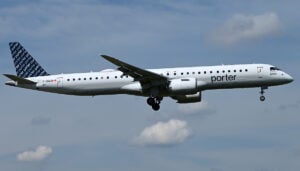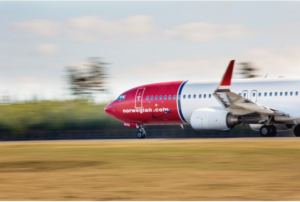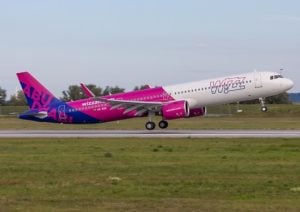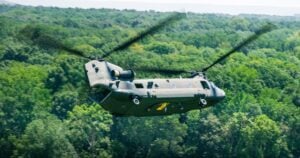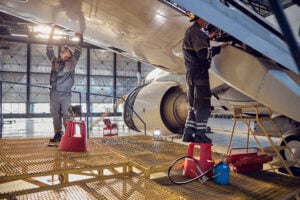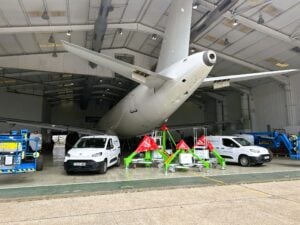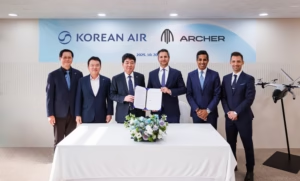By David Dundas
It is remarkable to think that drones have been with us since the days of the Vietnam war, yet it was only at the turn of the millennium that their potential for more than military use began to be explored further. By 2005 the commercial potential for drones had been recognised and when, in 2015, the DJI phantom drone with GOPS and an HD GoPro action camera was released, the commercial market for drones began to boom.
It was with the combination of drone technology, together with the advances in recording and storing digital imagery, that the use of drones for aircraft inspections became a possibility. Aircraft inspections, a critical component of aviation safety and efficiency, are now leveraging drones to enhance accuracy, reduce downtime, and cut costs and this article will delve into how drones are reshaping aircraft inspections, the benefits they bring, and the challenges the industry must address.
Why Aircraft Inspections Are So Important
Aircraft inspections are essential to ensure their structural integrity and operational safety. Traditional inspections previously required technicians to perform painstaking checks, often using scaffolding, lifts, or cranes to access hard-to-reach areas like the upper fuselage or tail. These methods, while effective, are time-consuming, labour-intensive, and subject to human error. With airlines and MROs constantly looking for more efficient ways to optimise maintenance while maintaining rigorous safety standards, drones have emerged as a complete game changer.
How Drones Are Used For Aircraft Inspections
When equipped with both sensors and high-resolution cameras, drones are able to perform a comprehensive inspection of the exterior of an aircraft in a fraction of the time it used to take. There are four key areas where drone inspections have helped to improve the aircraft inspection process.
First, through visual inspections, drones are able to capture highly detailed images and videos of an aircraft’s surface, identifying such issues as, but not limited to, corrosion, dents, or cracks. Then, through the use of infrared scanning, drones equipped with thermal cameras can detect anomalies, revealing hidden problems like electrical faults or fluid leaks while thanks to 3-D mapping, the more advanced drones can create precise 3-D models of an aircraft, enabling engineers to analyse damage or wear in greater detail. Finally, there is the ‘rapid response’ to a lightning strike, where drones can swiftly scan the aircraft for burn marks or structural damage, expediting its return-to-service process. This swift inspection process has been of huge benefit to commercial airlines whose planes, individually, can be struck by lightning on average once or twice in a year.
Benefits of Drone Technology Used in Aircraft Inspections
Perhaps one of the greatest benefits of drone technology is the amount of time a drone inspection can save. As an example, traditional inspections can take 6–8 hours or more, especially for large aircraft like the Boeing 777. Drones, however, can complete the same task in under two hours. This significant time saving reduces aircraft downtime and consequently improves operational efficiency. There then comes the improvement in technicians’ safety through the use of drones for aircraft inspections. Inspecting certain areas of an aircraft usually involves technicians working at heights which, regrettably, increases the risk of accidents. The use of drones eliminates the need for any technicians to work at height, instead enabling inspections to be conducted safely from the ground.
When you consider that manual inspections of an aircraft require the use of scaffolding, lifts and considerable manpower, plus they are time consuming, the use of drones for aircraft inspections can cut costs considerably, while enabling aircraft to return to service more efficiently. With drones lowering inspection costs, airlines can allocate resources more efficiently, investing in proactive maintenance rather than logistics-heavy inspections.
Once we introduce AI into the equation, the use of drones for aircraft inspections becomes even more effective. Drones equipped with AI-powered image analysis can detect minute defects that may be overlooked in manual inspections. This precision enhances the reliability of inspections and reduces the risk of undetected issues which, over time could develop into highly costly issues and more time on ground. It is also worth pointing out at a time when reducing carbon emissions is a challenge for all operators, the use of drones is an environmentally friendly option. To explain in greater detail, faster inspections mean aircraft spend less time on the ground with auxiliary power units running, reducing fuel consumption and carbon emissions.
Challenges and Considerations Facing the Use of Drones
While on the surface it would seem that the use of drones for aircraft inspections makes perfect sense on many levels, that doesn’t stop the adoption of any new technology needing to obtain regulatory approval. Aviation authorities such as the FAA and EASA have stringent regulations on drone operations near airports. Ensuring compliance requires airlines to obtain special permissions and to follow strict protocols.
Of course, new technology brings with it the requirement to learn new skills. As an example, technicians must be trained to operate drones and interpret the data they gather. This requires investment in new skill sets, including drone piloting and AI-based analytics. Beyond this, one must also remember that drones cannot be operated in all weather conditions. Their use is severely limited when it comes to periods of high winds and heavy rainfall or snowfall.
Finally, there is the challenge of integrating a new way of operating into an existing aircraft management system. Because the use of drones is so very different to the alternative labour-intensive method of checking an aircraft, the whole inspection system needs to be amended, yet in such a way as not to disrupt other aspects of an existing aircraft management system.
The Future of Drones in Aircraft Maintenance
There is no question that the use of drones in the field of aircraft maintenance will not be limited solely to aiding with inspections. Continual advancements in AI mean that it is unlikely to be long before AI-powered autonomous drones are introduced. These drones will be able to identify and prioritise repairs based on their severity. Then there is the opportunity for hybrid inspections, which will combine drone-collected data with augmented reality (AR) tools to guide technicians during repairs. We then come to the situation we can call ‘collaborative robotics’ where drones will work in collaboration with robotic arms for minor repairs, massively reducing the need for human input and reducing repair times.
In other words, drones will not be responsible solely for identifying repairs necessary for an aircraft, but they will also play an active role in the repair and maintenance of aircraft as well. The increased use of drone technology in aircraft inspections can be seen as a pivotal shift in aviation maintenance. By enhancing efficiency, safety, and accuracy, drones are helping airlines and MROs to meet the demands of a fast-paced industry without compromising on safety. While challenges remain, the benefits far outweigh the drawbacks, meaning that drones are already an indispensable tool in the future of aviation maintenance.













